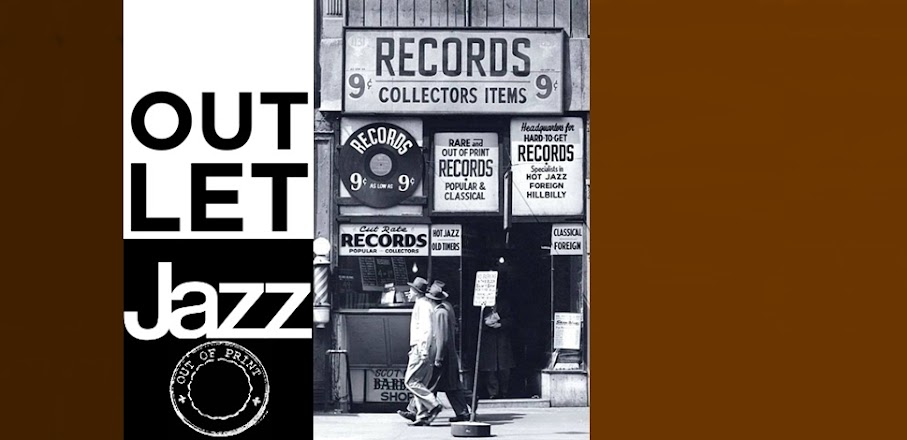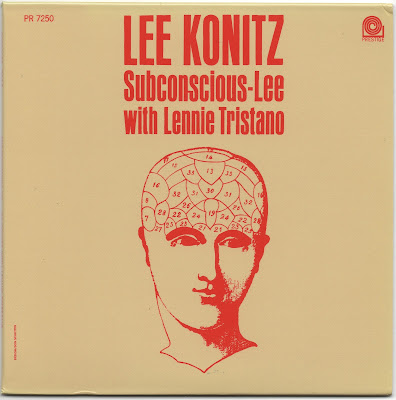Of the Lennie Tristano "school" of music, which predated the Lennie Tristano School of Music, Lee Konitz is the outstanding "pupil". Naturally Lennie's music had a great influence on Lee. Other influences are lesser and have been more completely absorbed in to the mainstream of his playing. For instance, in his rhythmic figures you can hear Charlie Parker (Bird left very few untouched and unmoved) but whatever sources Lee has drawn on have been integrated beautifully into his personal expression. His style and sound are both highly personal. The point of excellence as an individual voice is a signal triumph for any artist.
The three sessions in this LP show Lee off in many different ways with quintet, quartet and duo. The interplay with Tristano, duetting with Billy Bauer and unisons and exchanges with Warne Marsh are all self-illuminating examples of Lee's early work in this graphic collection of Konitz.
Incidentally, the Subconscious-Lee session not only launched Lee's career but was the first recording date of this company. New Jazz was then the label. * Ira Gitler*
One of THE key records in the Konitz school – a full length Prestige album that brings together important material from sessions originally issued on 10" LPs! The lineup here is virtually the Konitz school – with shifting lineups that include Billy Bauer on guitar, Lenny Tristano or Sal Mosca on piano, and Warne Marsh on tenor – all working as airily and fluidly as Konitz himself! How Lee managed to achieve such unity with his groups here will forever be a mystery to us – as will the freshness of the work at the end of the 40s, especially given that it's still arguably more "modern" than much of the jazz it inspired in years to come! *dustygroove.com*
A debut for both Lee Konitz and the Prestige label, Subconscious-Lee brings together many of the students who came through Lennie Tristano's idiosyncratic "school" of jazz during the immediate postwar years. Forging a heady approach to Charlie Parker's innovations, full of lithe and at times super fast solo lines, Tristano and his favorite pupil Konitz in particular nurtured an introverted, wan, yet still swinging alternative to the frenetic muscle of bebop. Other students like tenor saxophonist Warne Marsh, pianist Sal Mosca, and bassist Arnold Fishkin staked claims as well and show up prominently here. And while Tristano's "Judy" and "Retrospection" get mired in somewhat tired contemplation, Konitz' "Subconscious-Lee" and Marsh's "Marshmallow" stand out with brisk tempos, cascading horn lines, and fetching head statements. Avoiding the meandering course of his originals, Tristano shines at the piano with a bevy of exciting and substantial solos; Mosca and guitarist Billy Bauer keep up the good work with fine contributions of their own. Good for both mind and feet and chock-full of groundbreaking work by Konitz and Marsh especially, this 1949-1950 recording makes for essential jazz listening. One bonus track, "Progression," is added to thisversiónn of Subconscious-Lee. *Stephen Cook *
Recorded during the prime of bebop, between 1949 and 1950, Lee Konitz' Subconscious-Lee seems practically at odds with itself. It lacks the peculiarity and the exuberance that pours from the recordings of Charlie Parker, Thelonious Monk, and other post-swing experimentalists. It simultaneously seems old-fashioned and futuristic. Lee Konitz, who developed under the tutelage of pianist and pedagogue Lennie Tristano, was perhaps equally influenced by the technical fireworks of bebop, and Tristano's firm mindset. Tristano held that the rhythm section occupied a secondary role, and that improvisation should avoid overt sentimentality. Instead, Tristano and his students valued complexity andprecisiónn of harmony and rhythm. Their pursuit of pure musical devices, unaccompanied by emotional expression, is clearly evident on Subconscious-Lee, on which a sense of cool and detached concentration encircles the performances. The combination of impressive and inventive playing with a generally uncaring approach can be likened to the grunge rock movement of the late 1990s, when bands like Nirvana appeared to have no interest in winning over an audience, and all the while delivered powerful and deeply moving music. In other words, Konitz, Tristano, and frequent collaborator Warne Marsh, sound too cool for school. Tristano believed that a rhythm section's role was simply to provide the structure over which the improvisers could drape their melodies. He counseled drummers and bassists not to interact with soloists, and not to take the lead in musical events, such as swells in intensity. For this reason, much of this album, like others by Tristano, Marsh, and Konitz, sounds similar to antiquated practices of the hot jazz era, when the only instrumentalists given license to elaborate were the trumpeter and clarinetist. On the other hand, the rhythmic activity that Konitz and Marsh use to create winding and unpredictable lines sound as if they fit better into jazz from the 21st century. In fact, the contemporary jazz practice of disguising formal structure and steering clear of well-worn harmonic paths may have been in part influenced by this very school of improvisation.
Subconscious-Lee has one foot stubbornly planted in the past, and the other dangling in the capricious future. *Jacob Teichroew*
1 - Subconscious-Lee
(Lee Konitz)
2 - Judy
(Lennie Tristano)
3 - Progression
(Lee Konitz)
4 - Retrospection
(Lennie Tristano)
5 - Ice Cream Konitz
(Lee Konitz)
6 - You Go To My Head
(Fred Coots, Haven Gillespie)
7 - Marshmallow
(Warne Marsh)
8 - Fishin' Around
(Warne Marsh)
9 - Tautology
(Lee Konitz)
10 - Sound-Lee
(Lee Konitz)
11 - Palo Alto
(Lee Konitz)
12 - Rebecca
(Lee Konitz)
Lee Konitz (alto sax), Billy Bauer (guitar), Lennie Tristano (piano), Arnold Fishkin (bass), Shelly Manne (drums [#2, #3 out]).
Recorded in New York City, January 11, 1949.
#7, #8:
Lee Konitz (alto sax), Warne Marsh (tenor sax), Sal Mosca (piano), Arnold Fishkin (bass), Denzil Best (drums).
Recorded in New York City, June 28, 1949.
#9, #10:
Lee Konitz (alto sax), Warne Marsh (tenor sax), Sal Mosca (piano), Arnold Fishkin (bass), Jeff Morton (drums).
Recorded in New York City, September 27, 1949.
#5, #6, #11, #12:
Lee Konitz (alto sax), Billy Bauer (guitar), Sal Mosca (piano [#6 out]), Arnold Fishkin (bass [#12 out]), Jeff Morton (drums [#12 out]).
Recorded in New York City, April 7, 1950.


https://www.mediafire.com/file/8t2x0naloo4xzrt/LK_sbcnscusl.rar/file
ReplyDeleteGracias blbs. Ya lo estoy disfrutando. Hay un disco de Konitz, Oleo, que lo saco Sonet, muy recomendable. La version de I Remember Clifford siempre me parecio fantastica.
ReplyDeleteMuchas Gracias blbs por este nuevo aporte, lo disfrutare como siempre lo hago con tus entregas, saludos desde Chile.
ReplyDeleteMuchas gracias de nuevo.
ReplyDeleteMuchas gracias.
ReplyDeleteGracias!
ReplyDeleteGracias. Saludos,
ReplyDelete